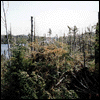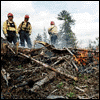|
|
Participate
|
CONTINUE THE CONVERSATION in MPR's online forum.
Go to forum
TAKE OUR POLL Should controlled burns be used in the Boundary Waters Canoe Area to try to reduce the risk of a major forest fire?
Go to survey
|
|
|
About Mainstreet
|
Mainstreet Radio started in 1987 with the mission of reporting from rural Minnesota to all of Minnesota. Each month, Mainstreet Radio presents a two-hour special focusing on rural issues.
Go to Mainstreet Radio
|
|

|
 A year ago a massive storm roared through the Boundary Waters Canoe Area, damaging 350,000 acres of trees. This month's Mainstreet broadcast will look at the impact the blowdown is having on the land and the people who love it. The show will be broadcast live from the covered pavilion in Whiteside Park during Ely's summer celebration, the Blueberry Festival.
A year ago a massive storm roared through the Boundary Waters Canoe Area, damaging 350,000 acres of trees. This month's Mainstreet broadcast will look at the impact the blowdown is having on the land and the people who love it. The show will be broadcast live from the covered pavilion in Whiteside Park during Ely's summer celebration, the Blueberry Festival.
|
| Forest Impact |
Listen to Part One |
|
SEVERAL HUNDRED THOUSAND trees blew down in last year's storm, creating near perfect conditions for a major forest fire. Experts say the only question is when the fire or fires will occur and how destructive they will be. The blowdown quadrupled the amount of fuel per acre that can readily burn and the fire risk is expected to increase in the next several years as the timber dries out.
 The U.S. Forest Service and Minnesota Department of Natural Resources have spent millions of dollars to beef up firefighting equipment and crews in the area and develop strategies to fight fires. To reduce the risk of a large fire, the Forest Service wants to set small, controlled fires in the wilderness beginning next year. Over the next five or six years, officials would burn as many as 8l,000 acres in the BWCA
The U.S. Forest Service and Minnesota Department of Natural Resources have spent millions of dollars to beef up firefighting equipment and crews in the area and develop strategies to fight fires. To reduce the risk of a large fire, the Forest Service wants to set small, controlled fires in the wilderness beginning next year. Over the next five or six years, officials would burn as many as 8l,000 acres in the BWCA
Guests:
Mark Van Every, U.S. Forest Service
Paul Tine, fire-fuels specialist with the Minnesota Interagency Fire Center
Lee Frelich, forest resources researcher at the University of Minnesota
|
|
| Human Impact |
Listen to Part Two |
|
CANOEISTS CONTINUE TO PADDLE the BWCA despite last year's storm which affected about a third of the area. The Forest Service reports that permits are only slightly below last year's figures. Officials are making sure BWCA visitors understand the increased fire danger and what to do in case of fire. Educational pamphlets, videos and briefings are available at forest service offices.
Outfitters report that about a fourth of their canoeists want to be sure and see the blowdown area and about the same number want to avoid it. Traveling through the Boundary Waters still provides a wilderness experience, they say, even if the landscape has changed.
Guests:
Lyle Williams, owner of Tom and Woods Wilderness Canoe Trips
Doug Hirdler, manager of Sommers Boy Scout Canoe Base on Moose Lake
Jim Brandenburg, nature photographer (see slideshow)
|
|

Made possible by a grant from the Blandin Foundation
|
|

|
|

 A year ago a massive storm roared through the Boundary Waters Canoe Area, damaging 350,000 acres of trees. This month's Mainstreet broadcast will look at the impact the blowdown is having on the land and the people who love it. The show will be broadcast live from the covered pavilion in Whiteside Park during Ely's summer celebration, the Blueberry Festival.
A year ago a massive storm roared through the Boundary Waters Canoe Area, damaging 350,000 acres of trees. This month's Mainstreet broadcast will look at the impact the blowdown is having on the land and the people who love it. The show will be broadcast live from the covered pavilion in Whiteside Park during Ely's summer celebration, the Blueberry Festival.
 The U.S. Forest Service and Minnesota Department of Natural Resources have spent millions of dollars to beef up firefighting equipment and crews in the area and develop strategies to fight fires. To reduce the risk of a large fire, the Forest Service wants to set small, controlled fires in the wilderness beginning next year. Over the next five or six years, officials would burn as many as 8l,000 acres in the BWCA
The U.S. Forest Service and Minnesota Department of Natural Resources have spent millions of dollars to beef up firefighting equipment and crews in the area and develop strategies to fight fires. To reduce the risk of a large fire, the Forest Service wants to set small, controlled fires in the wilderness beginning next year. Over the next five or six years, officials would burn as many as 8l,000 acres in the BWCA
